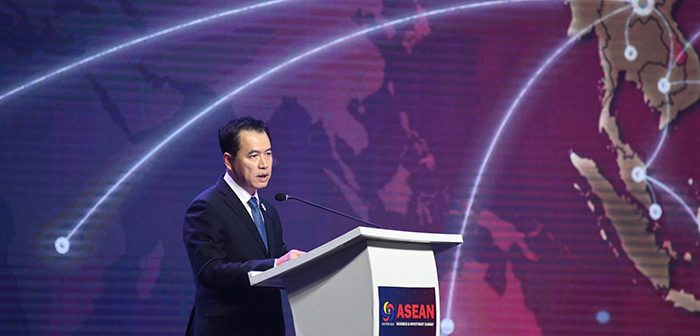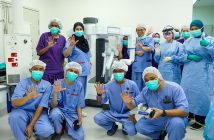
Secretary-General of ASEAN, Kao Kim Hourn, has delivered his opening remarks at the ASEAN Business and Investment Summit, held in Vientiane this week.
Kao emphasised the importance of the business community in supporting innovation, competitiveness, and creativity. He also highlighted the potential of exploring new untapped business opportunities, strengthening ASEAN’s connectivity, and building resilience for a more interconnected, prosperous future.
“It is my distinct pleasure to welcome you all to the 2024 ASEAN Business and Investment Summit,” his speech starts. “This prestigious gathering of business leaders, policymakers, and key stakeholders highlights the pivotal role of the private sector in shaping ASEAN’s economic future. I extend my heartfelt gratitude to the ASEAN Business Advisory Council for organising this platform to foster dialogue, innovation, and partnerships that will drive the region’s progress and prosperity.”
“We are convening at a pivotal moment, where the pressing global challenges and emerging opportunities call for a forward-looking vision and intensified collective efforts from the ASEAN Community. The current global economic outlook is profoundly influenced by geo-political tensions, particularly the Russia-Ukraine war, the on-going conflict in the Middle East, and the full-spectrum strategic competition between the US and China. These developments are not only disrupting supply chains and destabilising energy markets but are also fuelling protectionism and exacerbating trade fragmentation.”
“Slowing global growth, financial instability, and the increasing frequency of climate-related disasters are straining our resources and infrastructure, further worsening food insecurity and raising urgent concerns about long-term economic resilience. At the same time, the transition to renewable energy and shifts in the labour market, including automation, are fundamentally reshaping industries and changing global economic dynamic.”
“Addressing these interconnected challenges requires coordinated domestic and international policy efforts to navigate the evolving global landscape.”
“Despite these global economic headwinds, ASEAN’s outlook remains strong. Our region’s economy is projected to grow by 4.5% within this year and 4.7% in 2025, further strengthening our position as a key player in global markets. ASEAN has established itself as the world’s third-largest trading bloc, with total trade value at USD3.5 trillion, representing 9.5% of global trade. Intra-ASEAN trade, a vital component of our economic integration, accounts for 21.5% of the region’s total trade.”
“On the investment front, ASEAN has solidified its position as a premier global destination. In 2023, the region attracted nearly USD230 billion in foreign direct investment, ranking second worldwide after the United States and standing as the largest recipient among developing economies. These impressive figures underscore the success of ASEAN’s sustained efforts in deepening regional economic integration and embedding itself into the global supply chains.”
“This year’s theme, ASEAN: Enhancing Connectivity and Resilience, under chairmanship and leadership of Lao PDR, therefore underscores our shared vision of a more integrated region in an increasingly challenging global landscape. This is not merely a slogan, it reflects our commitment to creating collaborative and connected systems to ensure ASEAN’s continued relevance and success on the global stage. Connectivity is not mutually exclusive with resilience. Rather, it forms the bedrock for synergising our resources and aligning our policies, thereby enhancing our collective resilience to effectively respond to future crises and disruptions while seizing new opportunities for growth and development.”
“This Summit provides a unique opportunity for ASEAN’s government and business leaders to explore innovative solutions, form strategic partnerships, and unlock new business potential. It is critical that our discussions today focus on how we can further strengthen ASEAN’s connectivity, bolster our resilience, and create a prosperous, sustainable future for all.”
“I would like to highlight three key priorities to ensure ASEAN’s continued success in navigating today’s complex global landscape.”
“First, as I have highlighted, connectivity, whether physical, digital, or economic, is the backbone of ASEAN’s economy. As governments, we must continue working closely with the private sector to strengthen these links, which drive trade, investment, tourism and integration across the region.”
“A noteworthy example is the ASEAN Single Aviation Market, which has significantly boosted tourism recovery, professional mobility, and business ties, with nearly 102 million international tourist arrivals in 2023. The ASEAN-EU Comprehensive Air Transport Agreement, the world’s first bloc-to-bloc air transport agreement, has further strengthened air connectivity between our regions. Additionally, land transport initiatives like the ASEAN Framework Agreement on Facilitation of Goods in Transit and the ASEAN Customs Transit System have enhanced cargo transit efficiency by reducing border delays, improving the overall flow of goods across the region. These efforts must continue to be refined and expanded.”
“On the digital front, our region is moving towards the creation of a unified digital economy. With nearly 380 million active internet users, ASEAN is poised to harness the tremendous potential of the digital economy. The on-going negotiations for the world’s first comprehensive, legally binding Digital Economy Framework Agreement will serve as the bedrock of this digital transformation. By 2030, we expect ASEAN’s digital economy to contribute up to USD2 trillion to the region, positioning us as a digital powerhouse in the global economy.”
“Second, resilience is the cornerstone of our region’s ability to thrive in a rapidly evolving global landscape. ASEAN must not only withstand external shocks but also continue to innovate, remain competitive, and adapt to the changing environment.”
“Our resilience efforts are already yielding results, particularly in our commitment to a low-carbon economy. The ASEAN Strategy for Carbon Neutrality, the Framework for Circular Economy for the AEC, and the ASEAN Blue Economy Framework provide clear pathways towards sustainable development. Together, these initiatives could attract USD3.7 trillion in green investments and create close up to 50 million jobs by 2050.”
“At the same time, we are enhancing resilience by deepening economic integration within ASEAN and expanding our external relations. Internally, we are upgrading the ASEAN Trade in Goods Agreement to address both traditional trade challenges and emerging issues such as digital trade, decarbonisation, and the circular economy. This upgrade will also strengthen supply chain resilience by introducing provisions for trade during crises and improving dispute resolution mechanisms.”
“At the ASEAN Economic Ministers’ Meeting last month, chaired by His Excellency Malaithong Kommasith, we initiated the process to enhance the ASEAN Comprehensive Investment Agreement, aiming to boost transparency and investor confidence. These updates will ensure the agreement remains relevant, modern, and adaptive to the evolving global business landscape.”
“Externally, ASEAN has successfully concluded the upgrade of the ASEANAustralia-New Zealand Free Trade Area and implemented the Regional Comprehensive Economic Partnership, the world’s largest trade agreement. We continue to expand our trade network by upgrading free trade agreements with major economies like China and India, and negotiating a new one with Canada. Additionally, we are broadening economic cooperation with partners in the Middle East, Pacific, and Latin America. These agreements will lower trade barriers, reduce costs, harmonise standards, and bolster ASEAN’s resilience to external shocks, cementing our region’s position as a premier global trade and investment hub.”
“Third, creating a responsive environment for the private sector is vital for ASEAN’s continued success. Dynamic public-private partnerships will be key to realizing our full potential. Governments must focus on creating an enabling environment by reducing bureaucratic barriers, streamlining regulations, and enhancing customs procedures to promote seamless trade and investment. The private sector, in turn, must remain a driving force in fostering innovation, generating employment, and contributing to sustainable development across the region.”
“ASEAN’s future is bright, but to fully realise its potential, we must commit ourselves to a shared vision, an affirmative agenda and collective action. Together, we can build a more connected, resilient, and prosperous ASEAN. By leveraging the strength of our partnerships, both within the region and beyond, we can ensure that ASEAN remains an attractive destination for investment and a key player in the global economy.”
“Looking ahead, I am pleased to note that ASEAN continues to develop the Strategic Plans for the ASEAN Community Vision 2045. For the business community, this signals our enduring commitment to deepening economic integration and capitalising on emerging mega-trends such as technological innovation and sustainability. Through these initiatives, ASEAN is positioning itself as a globally competitive and future-ready economy.”
“In this spirit, I am confident that the ASEAN Business and Investment Summit will serve as a platform for meaningful dialogue, collaboration, and tangible outcomes.”





